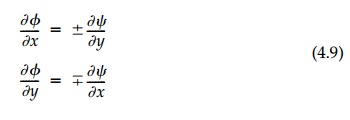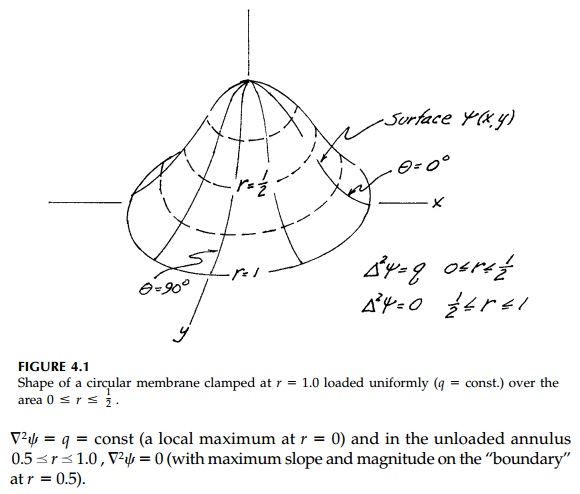Chapter: Civil : Principles of Solid Mechanics : Strategies for Elastic Analysis and Design
Properties of Elliptic Equations
Properties of
Elliptic Equations
Since we will deal primarily with elliptic
equations, let us list a few important properties of these field equations and
the associated boundary conditions:
a. Boundary
conditions must be Dirichlet or Neumann over a closed boundary. Part of
the boundary may be at infinity (where the slope must be zero).
b. The
scalar function, ![]() , can have no maxima or
minima inside the region where
, can have no maxima or
minima inside the region where ![]() 2
2![]() =
0. In other words, all maximums and mini-mums occur on the boundary of a
Laplacian field. This is obviously a very important property for engineers who
are particularly inter-ested in maximums and minimums.
=
0. In other words, all maximums and mini-mums occur on the boundary of a
Laplacian field. This is obviously a very important property for engineers who
are particularly inter-ested in maximums and minimums.
c. As
a consequence, if the boundary conditions start the field increas-ing in a
given direction, it has no choice but to continue increasing until it either
goes to infinity (not a maximum, but a singularity) or the opposite boundary
intervenes in time to stop it. That is why Cauchy conditions on an open
boundary are not suitable.
However, elliptic equations are strongly damping
(St. Venant's Prin-ciple). In fact, Laplace's equation is really a statement
that the function and its slope at any point is the average of the values at
neighboring points.
e. Elliptic
equations represent steady-state conditions. The field is what remains after
the transient or particular solution in time disappears. Thus the other types
of p.d.e.s (diffusion or wave equations) reduce to Laplace's equation when
changes due to time damp out. Therefore, it is not surprising, perhaps, that
elliptic equations are so common in the universe.*
d. Solutions
to the Laplace equation come in pairs called conjugate harmonic
functions. They obey the first-order Cauchy-Riemann con-ditions:

Thus taking the derivative of the first with respect
to x and the second with respect to y and adding, gives ![]() 2
2![]() = 0, or taking the derivative of the first with respect to y and
the second with respect to x and subtracting gives
= 0, or taking the derivative of the first with respect to y and
the second with respect to x and subtracting gives ![]() 2
2![]() = 0. One of the conjugate pair is often called the potential function and the
other the stream function.
= 0. One of the conjugate pair is often called the potential function and the
other the stream function.
g. The
solution to Laplace's equation is a flow net where lines of equal ![]() (contours of
(contours of ![]() ) intersect lines of
equal
) intersect lines of
equal ![]() (contours of
(contours of ![]() )
at right angles. The Cauchy-Riemann conditions [Equation (4.9)] also require
that the ratio of the adjacent sides of the resulting 'rectangles' remain
constant (usually taken as 1.0 so that the flow net becomes a system of
squares**). Actually
)
at right angles. The Cauchy-Riemann conditions [Equation (4.9)] also require
that the ratio of the adjacent sides of the resulting 'rectangles' remain
constant (usually taken as 1.0 so that the flow net becomes a system of
squares**). Actually ![]() contours can be flow
lines 'down' the
contours can be flow
lines 'down' the ![]() poten-tial 'hill' (the
surface of
poten-tial 'hill' (the
surface of ![]() plotted above the xy plane) or
plotted above the xy plane) or ![]() contours can be flow paths down the
contours can be flow paths down the ![]() potential hill. Constructing the flow net, which is an acquired skill is, in fact, a full
graphical solution to Laplace's equation.
potential hill. Constructing the flow net, which is an acquired skill is, in fact, a full
graphical solution to Laplace's equation.
h. The
contours of equal (![]() 1
+
1
+ ![]() 2)
or mean stress
2)
or mean stress ![]() m,
which we know now is either a potential or a stream function if the body force
is zero or constant, are called isopachics.
m,
which we know now is either a potential or a stream function if the body force
is zero or constant, are called isopachics.
Another elliptic equation which plays a major role
in static elasticity is the nonhomogeneous Poisson's equation:

which arises when there
is a source or sink q(x,y) in the field. For example,
electric charge density, p, causes a negative concentration of the
electric potential, V, so that ![]() 2V
=-cp
or a source of heat, Q, causes a concentration in temperature T
so that
2V
=-cp
or a source of heat, Q, causes a concentration in temperature T
so that ![]() 2T
=
KQ.
2T
=
KQ.
One way to visualize
the Laplace and Poisson equations is to consider a perfectly elastic membrane
in equilibrium under a uniform tension applied around its edge. If the edge
lies entirely in a plane (perhaps tilted), the trivial solution ![]() =
ax + by + c results. If
the boundary edge is now distorted into a nonlinear shape, the membrane is
distorted also, but its height above the plane
=
ax + by + c results. If
the boundary edge is now distorted into a nonlinear shape, the membrane is
distorted also, but its height above the plane ![]() (x,y)
still satisfies
(x,y)
still satisfies ![]() 2
2![]() =
0. The tension straightens out all the 'bulges' introduced at the boundary and
the displacement at any point equals the average of the neighboring points. One
can also say that the membrane has arranged itself so that the average slope is
a minimum. Thus the field condi-tion
=
0. The tension straightens out all the 'bulges' introduced at the boundary and
the displacement at any point equals the average of the neighboring points. One
can also say that the membrane has arranged itself so that the average slope is
a minimum. Thus the field condi-tion ![]() 2
2![]() =
0 damps out all the edge values (St. Venant's principle) so that the membrane
assumes a shape with the minimum stretching possible.
=
0 damps out all the edge values (St. Venant's principle) so that the membrane
assumes a shape with the minimum stretching possible.
If now a distributed force, q(x,y),
normal to the stretched membrane (which already satisfies ![]() 2
2![]() = 0) is applied, the membrane will bulge. The Laplacian
= 0) is applied, the membrane will bulge. The Laplacian ![]() is now proportional to this load per unit area, q, at any point. Shown
in Figure 4.1 is a circular membrane loaded uniformly over the area 0 <=
r <= 0.5 , and unloaded 0.5 <=
r <= 1.0 . In the center region we have Poisson's
equation
is now proportional to this load per unit area, q, at any point. Shown
in Figure 4.1 is a circular membrane loaded uniformly over the area 0 <=
r <= 0.5 , and unloaded 0.5 <=
r <= 1.0 . In the center region we have Poisson's
equation

It is important to recognize that superposition
holds for the Laplacian. If the boundary of the membrane in Figure 4.1 is now
distorted, the new mem-brane shape will be simply ![]() +
+ ![]() where
where ![]() is the solution of
is the solution of ![]() 2
2![]() = 0 for the membrane satisfying the distorted boundary. This is very useful in
matching boundary conditions in that any amount of any solution of Laplace's
equa-tion
= 0 for the membrane satisfying the distorted boundary. This is very useful in
matching boundary conditions in that any amount of any solution of Laplace's
equa-tion ![]() 2
2![]() = 0 0 (homogeneous) can be added to
= 0 0 (homogeneous) can be added to ![]() and still have a
solution of
and still have a
solution of ![]() 2
2![]() = q for
the same particular q.
= q for
the same particular q.
Related Topics